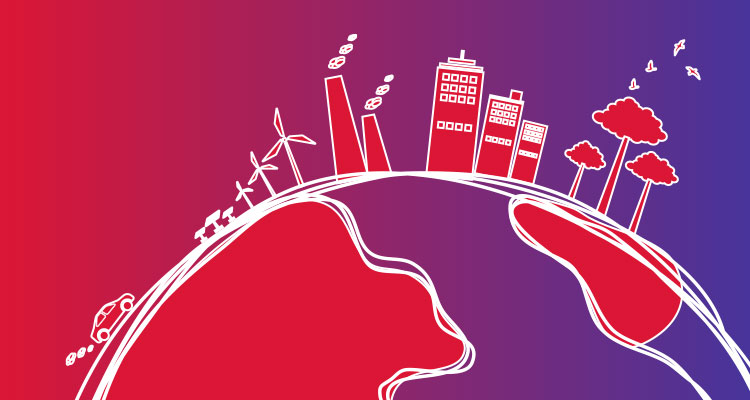
The role of business and data in advancing climate action By Rich Hampshire
It should be no surprise that any conversation about delivering net zero commitments, quickly leads to a discussion on the energy transition.
The energy transition is itself a multi-faceted challenge that can accelerate meaningful climate action. The World Resource Institute claims 73 percent of global greenhouse gas (GHG) emissions arise from the consumption of energy. Almost 30 percent of total GHG emissions are created by energy use in buildings and road  transport. Electrification has an important role to play in addressing these, but only if the electricity consumed is decarbonized!
transport. Electrification has an important role to play in addressing these, but only if the electricity consumed is decarbonized!
The reconfiguration of the electricity system to integrate green generation connected deeper into the system and new sources of decarbonized demand may not be changing the laws of electrical engineering, but they do change the dynamics of the electricity system, fundamentally. The traditional sources of system flexibility, such as from dispatchable fossil fuel generation, are being made redundant as they are replaced by intermittent, inflexible renewable sources of supply. And those decarbonized sources of electricity are far greater in number and are typically distributed more widely across the system and at low voltage levels.
The electrification of demand that has been traditionally satisfied by fossil fuels, such as oil and gas, presents challenges and opportunities. The challenges come from optimizing investment in both infrastructural networks and new generation capacity. The opportunities arise from reconfiguring how the electricity system is designed and operated as well as from how it is governed and how electricity markets can be reformed to encourage active participation of demand. Making markets work for both capacity and energy flexibility services can create meaningful new choices for how we all, as consumers, satisfy our energy needs and manage our overall energy bills.
Democratization of energy
It’s no understatement to say that this move to a more dynamic, distributed energy system also increases the market power of the demand side and the consumer. For the first time, those consumers that choose to allow their active, decarbonized demand (such as electric vehicles, heat pumps and storage) to participate in the electricity system or take advantage of the services offered by their energy supplier or services provider, can become price makers rather than passive price takers. This is sometimes referred to as the ‘democratization’ of energy.
I’ve had the privilege of discussing what drives the energy transition in different countries and under different market structures and regulatory governance. Whilst the economic drivers and timescales vary and the implementation challenges are different depending on the degree of vertical integration (those national and municipality utilities serving consumers from their power stations to beyond the consumers’ plugs) or horizontal disaggregation across the value chain (such as in Britain and Australia), the challenges are similar – it’s a matter of clarity on respective roles and responsibilities, securing the required investment, access to the necessary skills, and making sure that consumers continue to have the reliable access to energy we’ve come to expect.
Enhanced visibility
The opportunities for organizations to redefine themselves and realign their business models are enormous.
The common theme is the need for visibility of what is happening in the system, both physically and  behaviorally. Such visibility informs more timely decision taking on the operation of the system and in rewarding consumers for allowing their smart devices to actively participate in the system. And hence support a managed transition.
behaviorally. Such visibility informs more timely decision taking on the operation of the system and in rewarding consumers for allowing their smart devices to actively participate in the system. And hence support a managed transition.
Getting that visibility, in turn, leads to the need for timely acquisition, analysis and access to data from across the system; from smart meters at the point of connection to network sensors throughout the infrastructure, to visibility of system actors’ planned actions to inform operational decision making.
The insights that can be gained from such visibility can inform more than just optimization of the operation of the physical system. These insights can enable the energy markets to be reformed and consumers to be rewarded for making available to the system the inherent flexibility of their smart, decarbonized generation, storage, and demand. The capability to control both demand and supply against system price signals can empower consumers to take control of their overall energy bills.
Market clarity
Research commissioned by CGI has demonstrated that the barriers to achieving such a dynamic, decarbonized energy system aren’t technical. The challenges identified include clarity on the market framework within which businesses operate, identification and management of conflicts of interest between different market actors, and visibility of each other’s actions. Equally, in other research, our clients have identified the need for cultural shifts, especially in attitudes to risk, and for these to be encouraged by, and reflected in, regulation.
The energy transition creates more than new business opportunities and the opportunity to transform the relationship with consumers. It challenges traditional ways of working with supply chains, especially in the digital domain where collaboration on creating value from data, and access to digital skills and delivering a cybersecurity system become increasingly important.
Rich Hampshire is Vice President Digital Utilities at CGI UK.
Founded in 1976, CGI is among the largest independent IT and business consulting services firms in the world. With 91,000 consultants and professionals across the globe, CGI delivers an end-to-end portfolio of capabilities, from strategic IT and business consulting to systems integration, managed IT and business process services and intellectual property solutions.